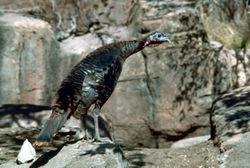Turkey (bird)
2007 Schools Wikipedia Selection. Related subjects: Birds
| iTurkey | ||||||||||||||
|---|---|---|---|---|---|---|---|---|---|---|---|---|---|---|
 Wild Turkey, Meleagris gallopavo
|
||||||||||||||
| Scientific classification | ||||||||||||||
|
||||||||||||||
|
|
||||||||||||||
|
M. gallopavo |
A turkey is either one of two species of large birds in the genus Meleagris. Turkeys are classed in the gamebird order. Formerly, they were considered a distinct family, Meleagrididae, but more recently they were reclassified as a subfamily (Meleagridinae) of the pheasants and their allies. As with many galliform species, the female is smaller than the male, and much less colourful. With their wingspans of 1.5-1.8 meters, the turkeys are by far the largest birds in the open forests in which they live, and are rarely mistaken for any other species.
The two species are the North American Wild Turkey (M. gallopavo) and the Central American Ocellated Turkey (M. ocellata).
The modern domesticated turkey was developed from the Wild Turkey. The Ocellated Turkey was probably also domesticated by the Mayans. It has been speculated that this species is more tractable than its northern counterpart, and was the source of the present domesticated stock, but there is no morphological evidence to support this theory. In particular, the chest tuft of domestic turkeys is a clear indicator of descent from the Wild Turkey, as the Ocellated Turkey does not have this tuft.
Turkeys are widely hunted, particularly the Wild Turkey in North America. Unlike their domestic counterparts, the turkeys are wary and agile flyers.
Naming
When Europeans first encountered these species in the Americas, they incorrectly identified them with the African Helmeted Guineafowl (Numida meleagris), also known as the turkey-cock from its importation to Central Europe through Turkey, and the name of that country stuck as also the name of the American bird. The confusion is also reflected in the scientific name: meleagris is Greek for guinea-fowl.
The names for the domesticated Turkey in other languages also frequently reflect its exotic origins, seen from an Old World viewpoint, and confusion about where it actually comes from. The many references to India seen in common names go back to a combination of two factors: first, the genuine belief that the newly-discovered Americas were in fact a part of East Asia, and second, the tendency to attribute exotic produce to some particular place that at that time symbolized far-off, exotic lands. The latter is reflected in terms like " Muscovy Duck" (which is from South America, not Muscovy) and indeed was a major reason why the name "turkey-cock" was transferred to Meleagris species.
For names in other languages for the Wild Turkey, see list of names for the Wild Turkey.
Several other birds which are sometimes called "turkeys" are not particularly closely related: the Australian brush-turkey is a megapode, and the bird sometimes known as the "Australian turkey" is in fact the Australian Bustard, a gruiform.
Asexual reproduction
Turkeys are notable for their ability, rare amongst higher species, to reproduce asexually. In the absence of a male, female Turkeys are known to produce fertile eggs. The individual produced is often sickly, and nearly always male. This behaviour can interfere with the incubation of eggs in Turkey farming.
Fossil turkeys
Many turkeys have been described from fossils. The Meleagridinae are known from the Early Miocene (c.23 mya) onwards, with the extinct genera Rhegminornis (Early Miocene of Bell, USA) and Proagriocharis (Kimball Late Miocene/Early Pliocene of Lime Creek, USA). The former is probably a basal turkey, the other a more modern bird not very similar to known turkeys; both were much smaller birds. A turkey fossil not assignable to genus but similar to Meleagris is known from the Late Miocene of Westmoreland County, Virginia (Olson, 1985).
In the modern genus Meleagris, a considerable number of species have been decribed, as turkey fossils are robust, fairly often found, and turkes show much variation among individuals. Many of these supposed fossil species are now considered junior synonyms. One, the well-documented California Turkey Meleagris californica, became extinct recently enough to have been hunted by early human settlers, though its actual demise is more probably attributable to climate change at the end of the last ice age. The modern species and the California Turkey seem to have diverged approximately one million years ago (Olson, 1985).
Turkeys known only from fossils:
- Meleagris sp. (Early Pliocene of Bone Valley, USA)
- Meleagris leopoldi (Late Pliocene of Cita Canyon, USA) - formerly Agriocharis
- Meleagris progenes (Rexroad Late Pliocene, Meade County, USA) - formerly Agriocharis
- Meleagris sp. (Late Pliocene of Macasphalt Shell Pit, USA)
- Meleagris anza (Early Pleistocene of San Diego County, USA)
- Meleagris californica (Late Pleistocene of SW USA) - formerly Parapavo/Pavo
- Meleagris crassipes (Late Pleistocene of SW North America)


